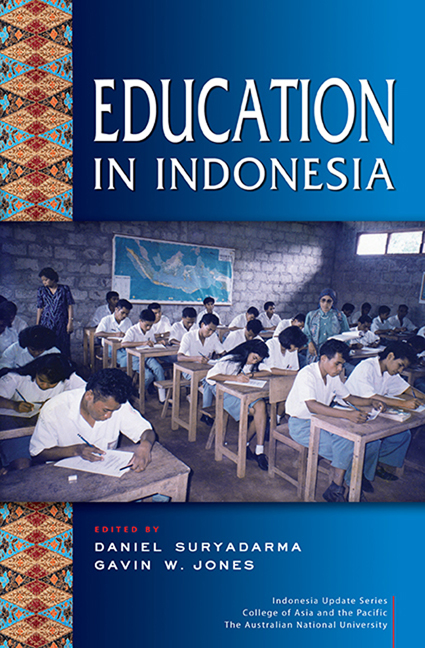Book contents
- Frontmatter
- Contents
- Tables
- Figures
- Contributors
- Acknowledgments
- Glossary
- 1 Meeting the Education Challenge
- 2 Trends in Education in Indonesia
- 3 Teacher Training, School Norms and Teacher Effectiveness in Indonesia
- 4 Integrating Islamic Schools into the Indonesian National Education System: A Case of Architecture over Implementation?
- 5 Early Childhood Education and Development Services in Indonesia
- 6 Where Did All the Money Go? Financing Basic Education in Indonesia
- 7 An Assessment of Policies to Improve Teacher Quality and Reduce Teacher Absenteeism
- 8 Indonesian Universities: Rapid Growth, Major Challenges
- 9 Beating the Odds: Locally Relevant Alternatives to World-class Universities
- 10 Financing Higher Education: The Viability of a Commercial Student Loan Scheme in Indonesia
- 11 The Transformation and Internationalization of Higher Education: The Malaysian Experience
- 12 Role of the Education and Training Sector in Addressing Skill Mismatch in Indonesia
- Index
- Indonesia Update Series
2 - Trends in Education in Indonesia
Published online by Cambridge University Press: 21 October 2015
- Frontmatter
- Contents
- Tables
- Figures
- Contributors
- Acknowledgments
- Glossary
- 1 Meeting the Education Challenge
- 2 Trends in Education in Indonesia
- 3 Teacher Training, School Norms and Teacher Effectiveness in Indonesia
- 4 Integrating Islamic Schools into the Indonesian National Education System: A Case of Architecture over Implementation?
- 5 Early Childhood Education and Development Services in Indonesia
- 6 Where Did All the Money Go? Financing Basic Education in Indonesia
- 7 An Assessment of Policies to Improve Teacher Quality and Reduce Teacher Absenteeism
- 8 Indonesian Universities: Rapid Growth, Major Challenges
- 9 Beating the Odds: Locally Relevant Alternatives to World-class Universities
- 10 Financing Higher Education: The Viability of a Commercial Student Loan Scheme in Indonesia
- 11 The Transformation and Internationalization of Higher Education: The Malaysian Experience
- 12 Role of the Education and Training Sector in Addressing Skill Mismatch in Indonesia
- Index
- Indonesia Update Series
Summary
INTRODUCTION
Indonesia has made notable improvements in education over the past 40 years, in line with the implementation of a number of key policies and programs. In 1973, the country embarked on a program to build a primary school in every village. The government made six years of education compulsory in 1984, and extended this to nine years in 1994. Other major policies to lift the standard of education have included the decentralization of education to the regions, an emphasis on pro-poor initiatives and the introduction of programs to improve teacher quality.
This chapter presents evidence on trends in educational performance in Indonesia using the data described in section 2.2. The analysis covers educational attainment (section 2.3), student enrolments and school progression rates (section 2.4), the provision of educational resources such as schools and teachers (section 2.5), student learning outcomes (section 2.6) and and the budget for education (section 2.7). The data are disaggregated where necessary to show the differences between provinces, between urban and rural areas, between males and females and between rich and poor. The analysis focuses on the past decade but in some cases covers a considerably longer period.
DATA SOURCES AND EVALUATION
To examine educational performance, this study uses published data on school statistics for academic years 1991/92 to 2009/10 collected by the Center for Education Data and Statistics, Ministry of Education and Culture; online data on educational attainment and school enrolments for 1994–2010 provided by Indonesia's central bureau of statistics (Badan Pusat Statistik, BPS); published data on educational performance for 1967–93 in the presidential reports submitted by the National Development Planning Agency (Badan Perencanaan Pembangunan Nasional, Bappenas); micro data on teachers for the year 2010 from the Ministry of Education and Culture; micro data from the National Socio-Economic Survey (Survei Sosio-Ekonomi Nasional, Susenas) for 1994–2010; and statistics for the period 1993–2008 from BPS's Village Potential (Potensi Desa, Podes) surveys.
The Center for Education Data and Statistics makes its statistics on schools available to researchers upon request. The data provide information on the numbers of students, the numbers and qualifications of teachers and principals, and the physical facilities owned by the schools. However, the statistics do not cover all schools because many of them do not complete the questionnaires sent to them annually; the return rate for junior secondary schools in 2009/10, for example, was only about 50 per cent.
- Type
- Chapter
- Information
- Education in Indonesia , pp. 15 - 52Publisher: ISEAS–Yusof Ishak InstitutePrint publication year: 2013

